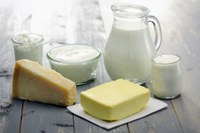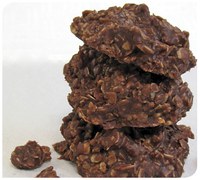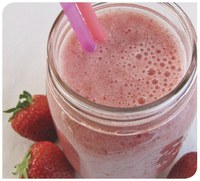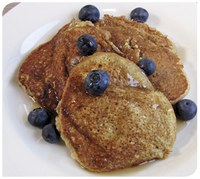All About Food Allergens: Milk (FN1831, March 2017)
Availability: Web only

What is the difference between a milk intolerance and a milk allergy?
A food allergy causes a reaction of the immune system that affects multiple organs. Food intolerance symptoms typically are not life-threatening and may include intestinal discomfort (pain, gas, diarrhea). A person with a milk allergy must avoid all milk-containing foods.
On the other hand, a person with lactose intolerance lacks an enzyme to digest the sugar in milk (lactose). This is different from a milk allergy. Typically, those with lactose intolerance can drink lactose-free milk or take a lactase enzyme pill before they consume foods containing lactose. Some people with lactose intolerance tolerate cheese or smaller amounts of milk (such as 1 cup) with meals.
What are the symptoms of a milk allergy?
• Hives
• Wheezing or impaired breathing
• Vomiting
• Loose stools that may contain blood
• Diarrhea
• Abdominal cramps
• Itchy skin rash (commonly around the mouth)
What ingredients/foods should I avoid if I am allergic to milk?
• Butter or butter products
• Casein, whey or milk protein products
• Cheese, cottage cheese, sour cream
• Creams, custards and puddings
• Lactose, lactulose, lactoferrin
• Milk or milk products
• Yogurt
If you are allergic to milk, look for “contains milk or milk products” after the ingredient list on food labels. If you are at a restaurant, make sure the staff are aware of your allergy so they can show you options that are safe for you to eat. If you are unsure if a product contains milk, do not eat it.
Note: People allergic to cows’ milk often need to avoid milk from other domesticated animals such as goats because goats’ milk protein is similar to cows’ milk.
How much of a food allergen can cause a reaction?
The amount of milk needed to cause an allergic reaction can vary for each individual. Sometimes consuming trace amounts can cause people to have an allergic reaction, but in more severe cases, even skin contact with dairy can cause an allergic reaction.
How soon will a reaction start after eating a food?
Symptoms of a milk allergy can occur within minutes or up to a few hours after eating a food. Sometimes two sets of symptoms may appear. First, a symptom may occur and then go away after a while, but then a more severe reaction may occur hours after the first.
What are businesses/food manufacturers doing to avoid reactions?
A variety of new codes and standards have been set for food manufacturing. These businesses must avoid cross-contact of foods. Many labels state the other foods made in the factory. Restaurants may label their menu with items free of certain allergens.
What is the best treatment for a severe reaction to a food allergy?
Severe reactions require immediate medical intervention, so call 911. Epinephrine is the first-line treatment for anaphylaxis, a rare but severe whole-body allergic reaction that causes severe symptoms, including tightening of the airway. After a food allergy diagnosis is made, your allergist likely will prescribe an epinephrine auto-injector and teach you how to use it.
Recipes
Key to abbreviations:
c. = cup
Tbsp. = tablespoon
tsp. = teaspoon
g = gram
mg = milligram
*These recipes are prepared without cows’ milk; “milk” derived from almonds is used as a substitute. Note: Be sure to check the ingredient statements on food package labels to avoid allergens in these recipes.
No-bake Cookies (Milk-free)

½ c. almond milk
½ c. peanut butter
½ c. cocoa
1 tsp. vanilla
1½ c. sugar
2½ c. quick-cooking oats
½ c. canola oil
In 2-quart saucepan over medium-high heat, mix milk, cocoa, sugar and oil. Bring to a boil and boil for two minutes. Remove from heat and stir in peanut butter and vanilla, then add oats. When dough is well-blended, put into a greased 8- by 8-inch pan and cut into bars or drop by teaspoonful onto waxed paper. Let cool.
Makes 20 servings. Each serving has 170 calories, 10 g fat, 3 g protein, 22 g carbohydrate, 2 g fiber and 35 mg sodium.
Strawberry Banana Smoothie (Milk-free)

2 c. fresh strawberries (frozen can be used)
1 banana
¼ c. unsweetened almond milk
2 Tbsp. honey (optional)
1 c. ice cubes
Add all the ingredients to a blender or food processor and blend until smooth.
Makes four servings. Each serving has 90 calories, 0.5 g fat, 1 g protein, 22 g carbohydrate, 2 g fiber and 15 mg sodium.
Banana Pancakes (Milk-free)

2 eggs
1 banana, mashed
½ c. oats (quick oats)
¼ c. applesauce
1 tsp. vanilla
½ tsp. cinnamon
Blend oats in blender or food processor until ground. Add remaining ingredients and mix until blended. Cook on a nonstick electric griddle or in a fry pan.
Makes four servings. Each serving has 120 calories, 3.5 g fat, 5 g protein, 17 g carbohydrate, 2 g fiber and 35 mg sodium.
More Information
Visit the U.S. Department of Agriculture Food and Nutrition Information Center.
recipe photos NDSU
MARCH 2017

